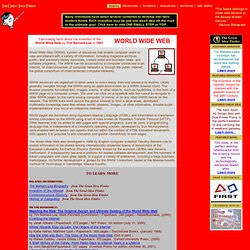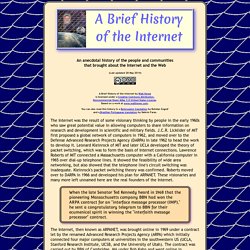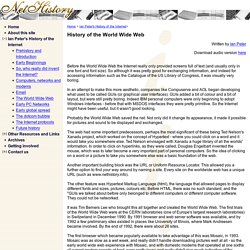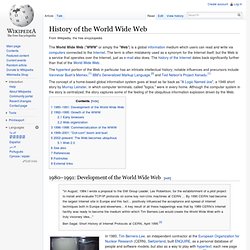

World Wide Web History - Invention of the World Wide Web. WWW resources are organized to allow users to move easily from one resource to another.

Users generally navigate through the WWW using an application known as a WWW browser client. The browser presents formatted text, images, sound, or other objects, such as hyperlinks, in the form of a WWW page on a computer screen. The user can click on a hyperlink with the cursor to navigate to other WWW pages on the same source computer, or server, or on any other WWW server on the network. The WWW links exist across the global Internet to form a large-scale, distributed, multimedia knowledge base that relates words, phrases, images, or other information. Smaller-scale implementations may occur on enterprise internets.
WWW pages are formatted using Hypertext Markup Language (HTML), and information is transferred among computers on the WWW using a set of rules known as Hypertext Transfer Protocol (HTTP). A Brief History of the Internet. An anecdotal history of the people and communities that brought about the Internet and the Web (Last updated 28 May 2014) A Brief History of the Internet by Walt Howe is licensed under a Creative Commons Attribution-Noncommercial-Share Alike 3.0 United States License.Based on a work at www.walthowe.com.

You can also read this history in a Belorussion translation by Bohdan Zograf and a Brazilian Portuguese translation by Valério Faras. The Internet was the result of some visionary thinking by people in the early 1960s who saw great potential value in allowing computers to share information on research and development in scientific and military fields. J.C.R. When the late Senator Ted Kennedy heard in 1968 that the pioneering Massachusetts company BBN had won the ARPA contract for an "interface message processor (IMP)," he sent a congratulatory telegram to BBN for their ecumenical spirit in winning the "interfaith message processor" contract.
Who was the first to use the Internet? History of the world wide web. Written by Ian Peter Download audio version here Before the World Wide Web the Internet really only provided screens full of text (and usually only in one font and font size).

So although it was pretty good for exchanging information, and indeed for accessing information such as the Catalogue of the US Library of Congress, it was visually very boring. In an attempt to make this more aesthetic, companies like Compuserve and AOL began developing what used to be called GUIs (or graphical user interfaces). GUIs added a bit of colour and a bit of layout, but were still pretty boring. Probably the World Wide Web saved the net. The web had some important predecessors, perhaps the most significant of these being Ted Nelson's Xanadu project, which worked on the concept of Hypertext - where you could click on a word and it would take you somewhere else. Another important building block was the URL or Uniform Resource Locator. The browser really did begin to change everything. Feedback Next.. History of the World Wide Web. The World Wide Web ("WWW" or simply the "Web") is a global information medium which users can read and write via computers connected to the Internet.

The term is often mistakenly used as a synonym for the Internet itself, but the Web is a service that operates over the Internet, just as e-mail also does. The history of the Internet dates back significantly further than that of the World Wide Web. The hypertext portion of the Web in particular has an intricate intellectual history; notable influences and precursors include Vannevar Bush's Memex,[1] IBM's Generalized Markup Language,[2] and Ted Nelson's Project Xanadu.[1] The concept of a home-based global information system goes at least as far back as "A Logic Named Joe", a 1946 short story by Murray Leinster, in which computer terminals, called "logics," were in every home.